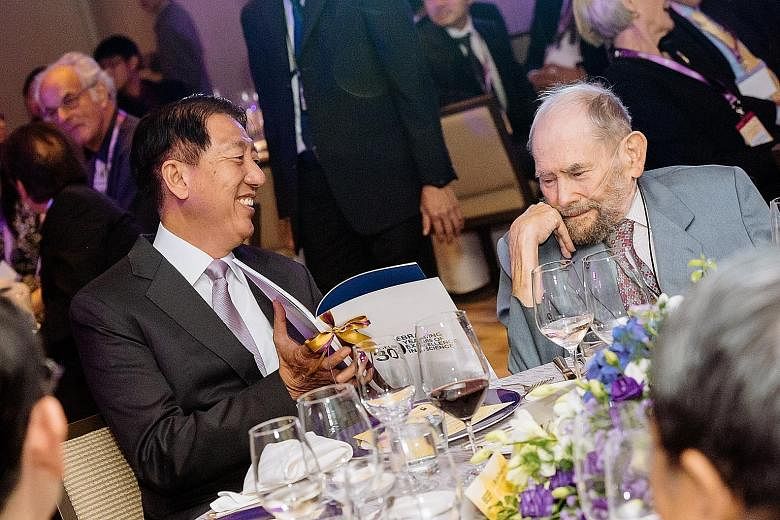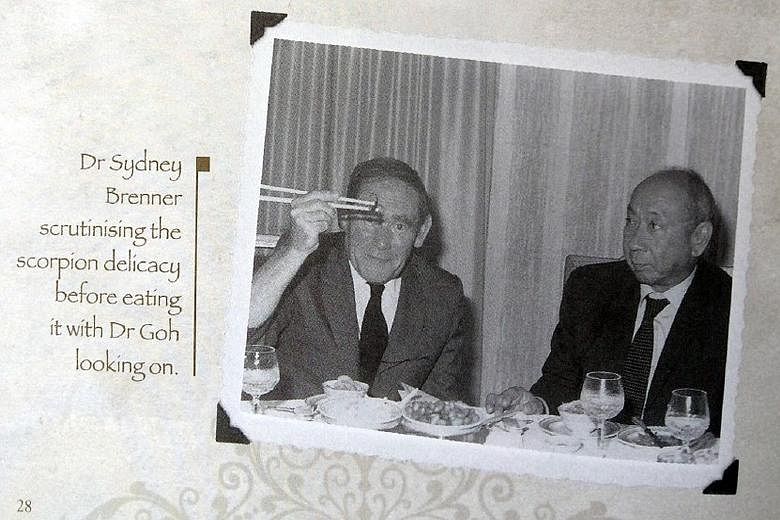Here are excerpts from A Heroic Voyage: Sydney Brenner's Life In Science, a companion booklet published by the Agency for Science, Technology and Research and Cold Spring Harbour Laboratory in conjunction with the 2015 Sydney Brenner Scientific Symposium and exhibition.
The excerpts include a foreword by Professor James Watson and other details about Dr Brenner's early life and scientific career.
AN EXCELLENT TRAVEL COMPANION, Message by James Watson, Chancellor Emeritus, Cold Spring Harbour Laboratory
Over the course of my career, I've had the privilege of tackling some of the most fundamental questions in biology, working alongside some of the finest minds in science to solve them. In this six-decade-long quest, Sydney Brenner has been an invaluable colleague and personal friend.
My first encounter with Sydney was in April 1953, in the heady days just after our discovery of the structure of DNA. Sydney had driven from Oxford to Cambridge that cold, spring morning - just to be among the first to look at our model. We went for a long walk that day - six hours as I recall, and the first of many over the years - because there was so much to talk about.
-
Nobel laureates to speak at event
-
Dr Sydney Brenner, born in South Africa in 1927, established the roundworm C. elegans as a model for studying developmental biology, now used as a standard research model by biologists worldwide.
Dr Brenner is a senior fellow at the Agency for Science, Technology and Research (A*Star), and a senior fellow at the Janelia Farm Research Campus, Howard Hughes Medical Institute in the United States.
He will be in Singapore to deliver a talk at a Nobel Laureate Public Lecture alongside two other Nobel prize winners, Professor James Watson and Professor Sir Richard Roberts, on Oct 1. Registration for the lecture is closed.
Distinguished speakers including Nobel laureates and other renowned biologists and physicists who have worked with Dr Brenner will also be giving presentations at The Sydney Brenner Scientific Symposium on Oct 2.
The exhibition on Dr Brenner's life in science entitled "A Heroic Voyage " will be open to the public from Oct 5 to Nov 3 from 9am to 5pm, Monday to Friday. Admission is free and it will be held at The Brenner Library, Level 5, Matrix, Biopolis. The booklet, "A Heroic Voyage: Sydney Brenner's Life in Science" will be given out to those who attend the public lecture, and scientific symposium on Oct 1-2.
Carolyn Khew
As important as it was, the structure of DNA was just one part of the puzzle; we still needed to figure out how the RNA transcribed from DNA could be "read" into proteins. Twenty of us, led by George Gamow, formed the RNA Tie Club, to share ideas on molecular biology... And it was Sydney who eventually worked out that the genetic code was non-overlapping and degenerate, and discovered what messenger RNA and ribosomes were really doing. As if all that wasn't enough, he followed it up by establishing an entirely different kind of model system - the nematode worm - so wonderfully complex and simple at the same time.
Then there were the exciting, frenetic years of the Human Genome Project. We kept up our exchanges, with him in the UK and me in the US, doing as much science as possible while being responsible for entire research institutes.
Genomics owes a great deal to him and his ideas; not just for the worm, which is what his Nobel Prize was for, but also technologies like massively parallel signature sequencing, which allowed gene expression to be analysed on a scale few could have imagined earlier.
We both embarked on our careers in an extremely exciting time for molecular biology and have enjoyed front-row seats. In 1954, Sydney and I actually drove through the eye of a hurricane while on a road trip across the US to Caltech. Then as now, I'm glad to have had such an excellent travel companion for the journey.
AN EARLY START
If you happened to be in the centre of the small town of Germiston in South Africa in 1939, you may have come across a stocky, 12-year-old boy coming out of the public library with a book that he had been allowed to borrow from the adults' section. You might have also seen him about a mile away down the main street, looking for frogs in the small stream that ran between his house and the starch factory; or in his garage extracting pigments from flowers.
The budding scientist, Sydney Brenner, was no ordinary teenager. As a child, he had not only read The Young Chemist - F. Sherwood Taylor's book for amateur chemists - but had already performed many of its experiments using small quantities of chemicals purchased from a pharmacy. His main interest, however, was in biology; plants and animals remained a source of fascination throughout his life. He also discovered early on that his "teachers did not know very much", and that many things could be learnt by reading and doing...
Sydney Brenner was born on Jan 13, 1927 in Germiston to Jewish immigrants from Russia. The family lived in a few rooms at the back of his father's cobbler shop.
When he was five, one of his father's customers - a certain "Miss Walkinshaw" - found him reading a newspaper. Impressed, she found him a place, with fees waived, at a private church school. At age six, he entered the local primary school two years ahead of his contemporaries, and completed the first three years of primary school in one year. Brenner began at the local high school when he was 11, and graduated just before he turned 14...
By the time he finished school, he knew he wanted to become a scientist, but his family was too poor to afford a university education for him. He won a bursary from the Town Council to study medicine and began a six-year medical course in early 1942 at the University of Witwatersrand - also known as Wits University. There, the 15-year-old studied physics, chemistry, botany and zoology, commuting by bicycle and train with packed sandwiches for lunch...
Two years into the six-year medical degree, Brenner was advised to take an extra gap year as he was too young to qualify for the practice of medicine...
Brenner spent a "heavenly" gap year in a medical Bachelor of Science course in anatomy and physiology. He was part of a group of about a dozen medical students, who worked closely with more advanced researchers in a small room in the department of anatomy...
Brenner once said that he was "the only medical student to graduate from Wits without ever laying hands on a patient until the actual final examination". His interest lay in scientific research and, specifically, molecular biology - "which, of course, did not exist at the time", as he later mused...
In the 1950s, Sydney Brenner's career progressed rapidly from the relative isolation of South Africa to Oxford University and the top scientific institutions in the US.
GENES, GENES AND MORE GENES
Molecular biology's golden age in the 1950s gave rise to a new era of developmental genetics in the 1960s...
Although Dr Brenner continued to work in what would be called classical molecular biology, by 1962, he was focusing on a small nematode worm, Caenorhabditis elegans (C. elegans)...
He chose a small nematode with a life cycle of five days and with a fixed number of cells. His goal was to find the lineage of every cell and in particular, to determine the structure of the nervous system with electron microscopy. He also needed an organism on which he could perform genetic experiments and easily keep in a laboratory...
His C. elegans research had begun to attract attention and from the mid-1970s, an increasing number of young scientists came to Cambridge to join him. Many were postdoctoral fellows who, upon their return to the US, established their own laboratories doing research on C. elegans, making it a successful global enterprise...
In 2002, Brenner and two of his former postdoctoral fellows, John Sulston and Bob Horvitz, were jointly awarded the Nobel Prize in Physiology or Medicine for their pioneering use of the nematode worm as a model for understanding human biology.
The title of Brenner's Nobel lecture in December 2002, "Nature's Gift to Science", was a homage to this modest nematode...
Brenner is nicknamed the "father of the worm"...
MENTORING A YOUNG NATION
In 1984, Sydney Brenner visited a tiny island in South-east Asia for the first time. Since then, his enduring guidance and influence have indelibly shaped the course of Singapore's biomedical science and industry.
It all began in 1981, when Brenner started consulting for British financier Victor Rothschild's Biotechnology Investments. It was Rothschild who recommended Brenner to the Singapore Government, which was eager to diversify the country's economy away from low-cost manufacturing to other industries, such as biotechnology.
Brenner came to a meeting in Singapore in 1984. He later discovered that this invitation had come from Dr Goh Keng Swee, then Deputy Prime Minister.
During this visit, Brenner met Mr Lee Kuan Yew, then Prime Minister of Singapore, and wrote a short proposal to set up a research institute in molecular and cell biology to train Singaporeans at the PhD level, who could then provide the country with the necessary biotechnology infrastructure. When Mr Lee remarked that Singapore was a nation of technicians and not scientists, Brenner candidly replied: "Prime Minister, if you don't do something like this, you will remain a nation of technicians." A decision was made in 1985 to create the Institute of Molecular and Cell Biology - a name Brenner had suggested...
• Professor James Watson, Dr Francis Crick and Professor Maurice Wilkins won the 1962 Nobel Prize for their discovery of the double-helix structure of DNA.



